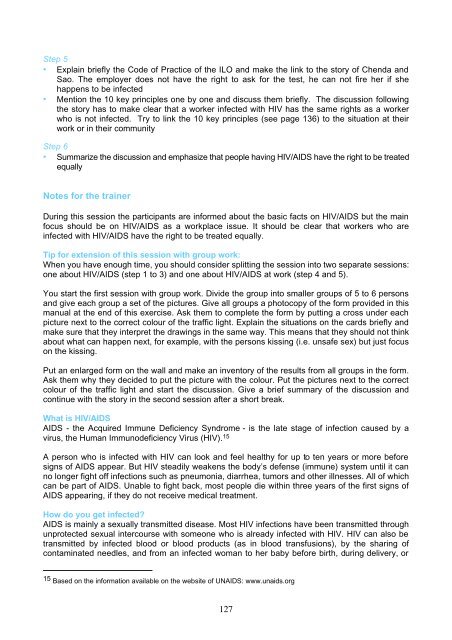manual: women workers' rights and gender equality - International ...
manual: women workers' rights and gender equality - International ...
manual: women workers' rights and gender equality - International ...
You also want an ePaper? Increase the reach of your titles
YUMPU automatically turns print PDFs into web optimized ePapers that Google loves.
Step 5<br />
• Explain briefly the Code of Practice of the ILO <strong>and</strong> make the link to the story of Chenda <strong>and</strong><br />
Sao. The employer does not have the right to ask for the test, he can not fire her if she<br />
happens to be infected<br />
• Mention the 10 key principles one by one <strong>and</strong> discuss them briefly. The discussion following<br />
the story has to make clear that a worker infected with HIV has the same <strong>rights</strong> as a worker<br />
who is not infected. Try to link the 10 key principles (see page 136) to the situation at their<br />
work or in their community<br />
Step 6<br />
• Summarize the discussion <strong>and</strong> emphasize that people having HIV/AIDS have the right to be treated<br />
equally<br />
Notes for the trainer<br />
During this session the participants are informed about the basic facts on HIV/AIDS but the main<br />
focus should be on HIV/AIDS as a workplace issue. It should be clear that workers who are<br />
infected with HIV/AIDS have the right to be treated equally.<br />
Tip for extension of this session with group work:<br />
When you have enough time, you should consider splitting the session into two separate sessions:<br />
one about HIV/AIDS (step 1 to 3) <strong>and</strong> one about HIV/AIDS at work (step 4 <strong>and</strong> 5).<br />
You start the first session with group work. Divide the group into smaller groups of 5 to 6 persons<br />
<strong>and</strong> give each group a set of the pictures. Give all groups a photocopy of the form provided in this<br />
<strong>manual</strong> at the end of this exercise. Ask them to complete the form by putting a cross under each<br />
picture next to the correct colour of the traffic light. Explain the situations on the cards briefly <strong>and</strong><br />
make sure that they interpret the drawings in the same way. This means that they should not think<br />
about what can happen next, for example, with the persons kissing (i.e. unsafe sex) but just focus<br />
on the kissing.<br />
Put an enlarged form on the wall <strong>and</strong> make an inventory of the results from all groups in the form.<br />
Ask them why they decided to put the picture with the colour. Put the pictures next to the correct<br />
colour of the traffic light <strong>and</strong> start the discussion. Give a brief summary of the discussion <strong>and</strong><br />
continue with the story in the second session after a short break.<br />
What is HIV/AIDS<br />
AIDS - the Acquired Immune Deficiency Syndrome - is the late stage of infection caused by a<br />
virus, the Human Immunodeficiency Virus (HIV). 15<br />
A person who is infected with HIV can look <strong>and</strong> feel healthy for up to ten years or more before<br />
signs of AIDS appear. But HIV steadily weakens the body’s defense (immune) system until it can<br />
no longer fight off infections such as pneumonia, diarrhea, tumors <strong>and</strong> other illnesses. All of which<br />
can be part of AIDS. Unable to fight back, most people die within three years of the first signs of<br />
AIDS appearing, if they do not receive medical treatment.<br />
How do you get infected?<br />
AIDS is mainly a sexually transmitted disease. Most HIV infections have been transmitted through<br />
unprotected sexual intercourse with someone who is already infected with HIV. HIV can also be<br />
transmitted by infected blood or blood products (as in blood transfusions), by the sharing of<br />
contaminated needles, <strong>and</strong> from an infected woman to her baby before birth, during delivery, or<br />
15 Based on the information available on the website of UNAIDS: www.unaids.org<br />
127

















